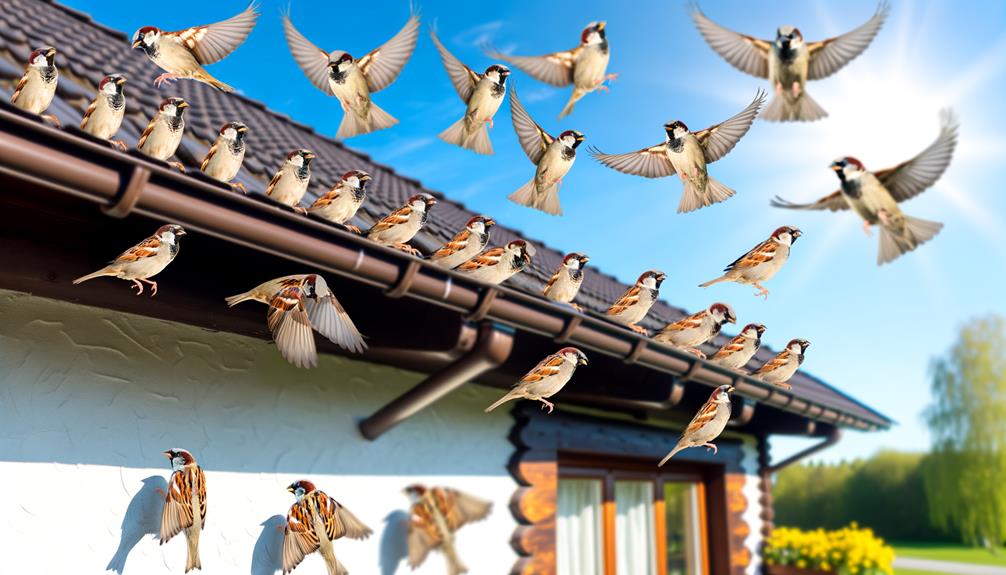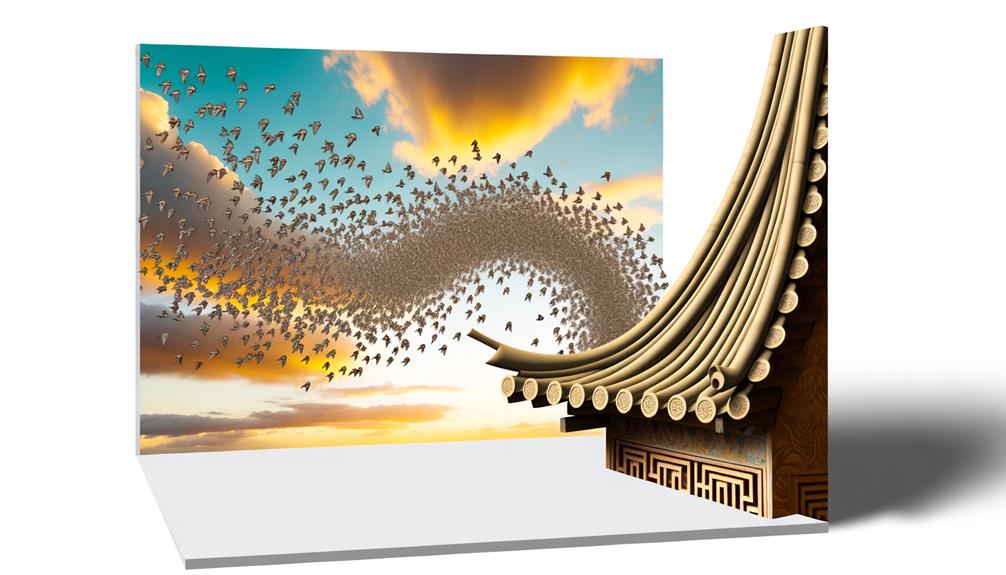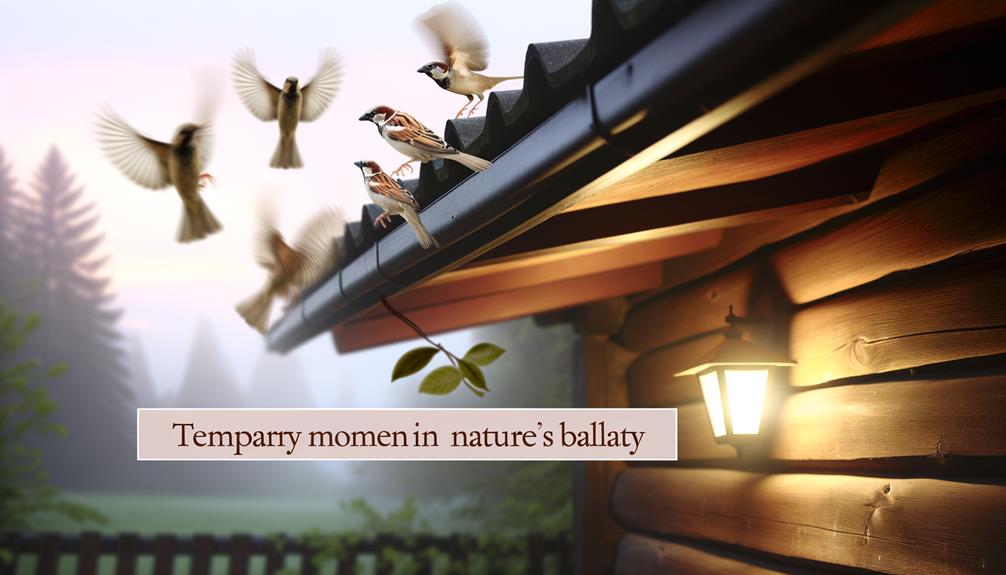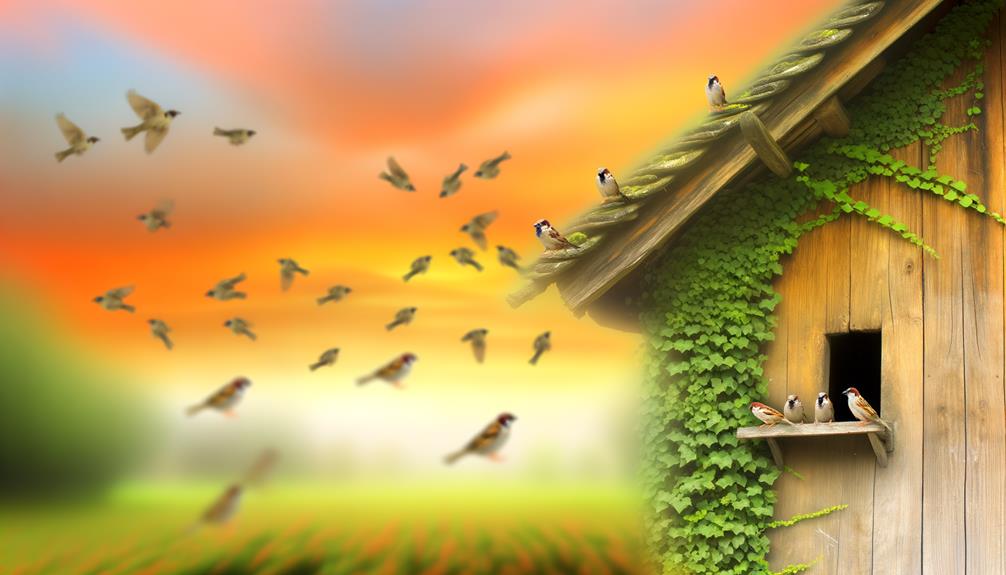What Is the Meaning of “Countless Sparrows Were Twittering in the Eaves”?
The phrase "countless sparrows were twittering in the eaves" evokes themes of communal interaction and nature's omnipresence, encompassing the Passeridae family's intricate social dynamics. Eaves, serving as a boundary between human habitation and the natural world, highlight the integration of avian species with urban environments.
The continuous vocalizations of Passer domesticus not only contribute to a tranquil ambiance but also reflect ecological shifts, such as seasonal changes. Sparrows symbolize resilience, freedom, and beauty in literature, embodying the interconnectedness between humans and nature.
Discovering more about this phrase uncovers deeper layers of ecological and symbolic significance.

Key Takeaways
- The phrase signifies themes of community, communication, and nature's omnipresence in human life.
- Sparrows symbolize freedom, survival, and the interconnectedness of living beings.
- Eaves represent the boundary between human habitation and nature, integrating natural elements into daily routines.
- Sparrows' twittering creates tranquility and promotes mental well-being through urban-natural interactions.
- Observing sparrows' behavior reflects seasonal changes and fosters ecological awareness and appreciation for biodiversity.
Literary Symbolism

The phrase 'countless sparrows were twittering in the eaves' employs literary symbolism to convey themes of community, communication, and the natural world's omnipresence.
Sparrows, scientifically known as Passeridae, exhibit gregarious behavior, illustrating the concept of community. Their vocalizations, or 'twittering', are complex communication forms within the avian taxa, reflecting intricate social interactions.
Eaves, architectural elements of roofs, symbolize a boundary between human habitation and the natural world. This phrase's descriptive nature underscores the pervasiveness of nature, even in human-altered environments.
The auditory imagery of sparrows' sounds in the eaves highlights the seamless integration of natural elements into daily life, emphasizing an interconnected biosphere.
Consequently, these symbols intricately weave biological and sociocultural themes into literary expression.
Connection to Nature
Examining the phrase 'countless sparrows were twittering in the eaves' reveals a profound connection to nature, as it encapsulates the intricate relationships between avian species and human environments.
Sparrows, particularly Passer domesticus, exhibit adaptive behavior, thriving in anthropogenic habitats. Their twittering, a form of vocal communication, signifies social interactions and territory establishment.
Eaves provide sheltered nesting sites, demonstrating how human structures inadvertently support avian life. This symbiotic relationship highlights the adaptability of sparrows, as they exploit available resources within urban ecosystems.
Observing these interactions underscores the interconnectedness of biodiversity and human-built environments, fostering appreciation for the ecological roles even common species play. Understanding such dynamics encourages harmonious coexistence with nature, preserving ecological balance.
Evoking Tranquility

Amidst the cacophony of urban life, the twittering of countless Passer domesticus in the eaves evokes a sense of tranquility, serving as a gentle reminder of nature's persistent presence. This small passerine bird, commonly known as the house sparrow, creates an acoustic refuge through its vocalizations, which have been scientifically noted for their calming effects on human psychology.
Key observations include:
- Species: Passer domesticus
- Habitat: Urban and suburban eaves
- Vocalization: Continuous chirping, fostering a serene ambiance
- Behavior: Social, often seen in flocks, enhancing communal feeling
- Impact: Positive psychological influence, reducing stress and anxiety
Such avian activities highlight the intersection of urban and natural environments, promoting mental well-being through simple, yet profound, biological interactions.
Passage of Time
The passage of time can be marked by observing the sparrows' behavior in relation to seasonal changes and daily rhythms.
Over the course of a year, variations in their vocalization patterns, nesting activities, and plumage molt provide clear indicators of different seasons.
Additionally, the sparrows' daily routines, such as their morning chorus and evening roosting, highlight the diurnal cycle's influence on their activities.
Seasonal Changes Observed
As autumn approaches, the sparrows' movement patterns shift noticeably, with *Passer domesticus* increasingly visiting the eaves in search of shelter from the cooling temperatures. Observations indicate several significant changes in their behavior during this period:
- Increased flocking behavior to conserve heat.
- Changes in vocalization patterns, likely to maintain social cohesion.
- Altered feeding habits, focusing on high-energy seeds.
- Enhanced use of urban structures for nesting and roosting.
- Reduced daytime activity, possibly as an energy conservation strategy.
These behavioral adaptations are critical for survival as they navigate the shift from warmer seasons.
The sparrows' dependence on human structures underscores their adaptability and the impact of seasonal changes on avian ecology. Understanding these patterns helps in predicting broader ecological shifts.
Daily Rhythms Noted
How do the diurnal patterns of *Passer domesticus* reveal underlying physiological and ecological adaptations to their urban environment?
These sparrows exhibit crepuscular activity peaks, aligning with human activity and availability of resources. They engage in foraging primarily during early morning and late afternoon, optimizing food intake while minimizing predation risk.
Their vocalizations serve critical roles in social cohesion and territorial defense, particularly intense at dawn and dusk. Urban environments provide diverse microhabitats, influencing nesting sites and predator avoidance.
The light pollution in cities extends their active periods, altering their circadian rhythms. These adaptive behaviors showcase the sparrows' remarkable ability to thrive in anthropogenic landscapes, reflecting complex interactions between their physiology and urban ecological pressures.
Fleeting Moments

Fleeting moments in avian behavior, such as the rapid twittering of sparrows in the eaves, illustrate the ephemeral nature of their social interactions and communication patterns.
Passer domesticus, commonly known as the house sparrow, exhibits a variety of transient behaviors that are essential for their survival and social cohesion. These behaviors include:
- Vocalizations: Short, high-pitched calls used for mate attraction and territorial defense.
- Flocking dynamics: Temporary group formations for feeding and predator avoidance.
- Preening: Brief grooming activities that maintain feather health.
- Feeding spurts: Quick, coordinated foraging sessions.
- Nest building: Rapid construction activities during the breeding season.
Each of these activities is characterized by its brevity, underscoring the dynamic and ever-changing nature of sparrow behavior.
Persistence Amidst Chaos
Observing Passer domesticus, one notes their remarkable ability to navigate daily disruptions, maintaining complex social structures amidst environmental unpredictability.
These avian subjects exhibit thriving behaviors in uncertain conditions, showcasing adaptive strategies essential for survival.
Their resilience through adversity exemplifies biological persistence, a key trait for species longevity.
Overcoming Daily Disruptions
The cacophony of sparrows twittering in the eaves exemplifies the relentless nature of environmental stimuli that individuals must navigate to maintain focus and productivity. In the face of such disruptions, Homo sapiens can employ various strategies to sustain their cognitive equilibrium.
Effective methods include:
- Cognitive compartmentalization: Isolating specific tasks to minimize cognitive overload.
- Ergonomic adjustments: Modifying physical workspaces to reduce distractions.
- Chronobiological scheduling: Aligning tasks with one's circadian rhythms for peak performance.
- Mindfulness practices: Implementing techniques like meditation to enhance focus.
- Acoustic management: Using sound-blocking tools or white noise to mitigate auditory disturbances.
These strategies, rooted in scientific principles, enable individuals to persist amid chaos and maintain productivity, despite the omnipresent environmental stimuli.
Thriving in Uncertainty
Amidst the omnipresent uncertainty, individuals can thrive by leveraging adaptive neuroplasticity to recalibrate their cognitive and behavioral responses.
Neuroplasticity, the brain's ability to reorganize itself by forming new neural connections, underpins resilience in chaotic environments. The prefrontal cortex (PFC), essential for decision-making and emotional regulation, adapts through synaptic plasticity, enabling individuals to maintain equilibrium.
Cortisol, a stress hormone, modulates these processes; however, chronic elevation impairs PFC function. Cognitive-behavioral techniques (CBT) and mindfulness practices can mitigate cortisol's impact, promoting neural adaptability.
Empirical evidence supports that enriching environments and deliberate practice enhance neuroplastic potential. Ultimately, understanding and harnessing these mechanisms allow individuals to not just endure but thrive amidst the inherent unpredictability of their surroundings.
Resilience Through Adversity
Building on the adaptive capabilities fostered by neuroplasticity, resilience through adversity hinges on the intricate interplay between cognitive strategies and physiological responses to stressors. This resilience manifests through a robust framework of behavioral and neuroendocrine mechanisms.
Individuals adept at maneuvering chaos exhibit:
- Enhanced prefrontal cortex function for decision-making.
- Optimized hypothalamic-pituitary-adrenal (HPA) axis regulation.
- Acute activation of the amygdala in threat detection.
- Elevated levels of neurotrophic factors, promoting neural survival.
- Adaptive stress-response via sympathetic nervous system moderation.
These components collectively underscore the dynamic balance between mental fortitude and somatic endurance.
Through detailed observation and empirical analysis, understanding this complex interdependence elucidates the pathways by which organisms persist amidst adversity, thereby fostering a broader comprehension of resilience's biological underpinnings.
Poetic Examples

In examining poetic examples, one observes that sparrows, often denoted by their taxonomic classification Passeridae, serve as a recurring motif in literature, symbolizing freedom and the beauty of nature's intricate symphony. Poets like John Keats and Emily Dickinson have frequently featured these avian subjects, emphasizing their roles within ecological systems and their melodic contributions to the environment.
Keats's verse, for instance, captures the delicate balance sparrows maintain in their habitats, while Dickinson's work often highlights their resilience and enduring presence. Their vivid descriptions utilize precise ornithological details, portraying Passeridae as more than mere birds, but as emblematic figures representing broader thematic elements of survival and the interconnectedness of life within poetic frameworks.
Diverse Interpretations
The phrase 'countless sparrows were twittering in the eaves' invites diverse interpretations, ranging from the depiction of ecological harmony to the evocation of intricate social structures within the Passeridae family.
Observers might perceive:
- Symbiotic relationships: Interactions with other avian species and insects.
- Nesting behavior: Insight into reproductive cycles and site selection.
- Acoustic communication: Variations in vocalization patterns and their meanings.
- Population dynamics: Indicators of species health and environmental conditions.
- Anthropogenic impact: Responses to human activity and urbanization.
Such interpretations provide a multi-faceted understanding of avian behavior, emphasizing the scientific importance of these small Passeriformes.
The observation of sparrows in eaves underscores the complexity of their ecological niche and their adaptive strategies within ever-changing habitats.
Conclusion
The countless sparrows twittering in the eaves symbolize nature's resilience and the tranquility it evokes amidst chaos.
Remarkably, sparrows, classified under the family Passeridae, demonstrate adaptability, with over 50 species thriving globally.
Their presence signifies fleeting moments of peace and the passage of time.
By invoking these images, the narrative bridges human emotion and natural cycles, offering a poetic reflection on life's continuity.
This intricate connection underscores nature's persistent, yet delicate, influence on our daily lives.






